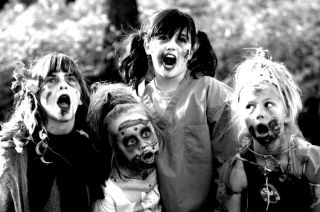In this playful, spooky season, hosts of fake witches, legions of little ghosts in flowing bedsheets, and swarms of assorted one-eyed pirates and Peyton Mannings will join mini-Wolverines and Catwomen and, together with a throng of Darth Vaders and Princess Leias, will troll neighborhoods for candy. The tradition of trooping from house to house on the eve of All Souls Day to beg hand-outs reaches back into the pre-Christian seasonal celebration of the Celts who, at the autumn equinox, appeased the fell spirits of an impending winter and the memory of their dead by offering gifts.
However well Halloween fit the pagan calendar, the holiday has reached its height in post-modern America where we can expect our fellow citizens to spend upwards of $11 billion this year on costumes and parties. Though most of us long ago left behind believing in ghouls and banshees, the main point of this festivity remains. Halloween is still meant to vanquish fear by portraying the fearful, but comically. In fact, we reassure ourselves by playing confidently at the edge of fright.
And so to the zombie. The zombie, out of West Africa by way of Haiti and then Hollywood, has risen to great popularity on the heels of recent productions like Zombie Apocalypse and The Walking Dead. It doesn’t really matter if a virus or a spell has animated the departed, it’s only important for the edgy game we play with our feelings that the creatures are famished, insatiable, and, unhappily for the living, cannibalistic and lurching in our direction.

The current zombie of television and film in fact joins a long line of not-quite-dead and not-quite-alive monsters that first rose in popular tales from the later 18th and early 19th centuries. Stories of the day were full with specters and spirits, the revivified dead, vampires, mysterious doubles, drug fiends, sleepwalkers, catatonic victims of premature burial, and evil automata. Mary Shelley’s Frankenstein’s monster appeared in 1818; Bram Stoker’s Count Dracula appeared in 1897. The genre still thrives. Think of Shawn of the Dead and True Blood, the television series that features some undead old enough to have read Dracula in the original. To those stories that highlight perambulating preserved bodies we’ve added modern touches; cold-minded aliens and morally vacant pod people, evil dolls, and flesh-clad cyborgs bent on our destruction. They hate us, they really hate us…
But what is it about these repulsive characters that we find so attractive that their very idea entertains us and in this season becomes part of Halloween play? The answer lies in the way we play with the edge of discomfort. Play often enlists the mischievous and disruptive, the transgressive and the alarming. But only up to a point; we like roller coasters and spooky movies as long as they’re only momentarily disturbing. Here, playing with the undead, perhaps joining one of the downtown midnight zombie walks that have surged in popularity around the country, we draw a queasy thrill from the odd sense that arises from an encounter with an object that looks real enough to be real, or that moves realistically enough to seem real and alive, but that is nevertheless not real or that seems not quite real or not quite alive.
I’ve written more fully about playing with this eerie feeling that psychologists call “the uncanny.” Engineers and film animators know of its peril, understanding that if the emotion becomes too strong during play it can spoil an animated film or ruin a promising animatronic toy. Remember the ill fated Polar Express, where the vinyl-skinned animated main character looked both too much like Tom Hanks and not enough like him? Recall the hyper-real robotic doll that bombed, My Real Baby? To guard against failure, robot designers and directors imagine a thin border that divides the fun from the creepy, between play and disgust, as lying at the edge of an “uncanny valley” that they dare not cross.
It is as if at play we can teeter at the rim playing with the sickly feeling, amusingly, but if we linger there too long or take one step too far we will tumble, nauseatingly, into the disturbing abyss. And there lying at the bottom we find the possessed puppet and the undead zombie. Play often rewards us with a thrill or a sense of wonder. But, just over the edge of play, uncanny objects like dolls, automata, robots, and realistic animations may become monstrous rather than marvelous. That’s the spot where play drains away.


